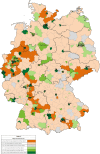Letter to the Editor: Analysis of stroke patient migration for mechanical thrombectomy and changes in neurointerventional center size in Germany
- PMID: 34092263
- PMCID: PMC8182903
- DOI: 10.1186/s42466-021-00131-2
Letter to the Editor: Analysis of stroke patient migration for mechanical thrombectomy and changes in neurointerventional center size in Germany
Abstract
Aim and methods: To analyse nationwide changes in neurointerventional center size of all German hospitals performing mechanical thrombectomy (MT) in stroke patients from 2016 to 2019. Furthermore, we assessed cross-district patient migration for MT for the first time using hospitals' structured quality reports and German Diagnosis-Related Groups data in 2019.
Findings: Number of hospitals performing more than 100 MT procedures/year doubled in Germany from 2016 (n = 36) to 2019 (n = 71), and these neurointerventional centers performed 71% of all MT procedures in 2019. The overall increase in MT procedures was largely driven by these high-volume neurointerventional centers with ability to perform MT 24/7 (121% increase as compared with 8% increase in hospitals performing less than 100 MT procedures/year). The highest cross-district patient mobility/transfer of stroke patients for MT was observed in districts adjacent to these high-volume neurointerventional centers with existing neurovascular networks.
Conclusion: The substantial increase in MT procedures observed in Germany between 2016 and 2019 was almost exclusively delivered by high-volume stroke centers performing more than 100 MT procedures per year in established neurovascular networks. As there is still a reasonable number of districts with low MT rates, further structural improvement including implementation of new or expansion of existing neurovascular networks and regional tailored MT triage concepts is needed.
Keywords: Health care structure; Neurointerventional center size; Patient migration; Stroke; Thrombectomy.
Conflict of interest statement
Ralph Weber received speaker honoria from Medtronic/Covidien and Bristol Myers Squibb.
Dirk Bartig received orders for analysis of the G-DRG system from Boehringer Ingelheim.
Christos Krogias received speaker honoraria and/or travel grants for scientific meetings from Bayer Vital, Boehringer-Ingelheim and Daichii-Sankyo.
Daniel Richter receives a FoRUM grant (K136–20) of the Ruhr-University of Bochum.
Werner Hacke received speaker and consultancy honoraria from Boehringer Ingelheim, Medtronic, Cerenovus and a research grant to perform ECASS4 from Boehringer Ingelheim.
Jens Eyding received travel grants from Boehringer Ingelheim and Bayer Vital and grants for the realization of scientific meetings by Bayer Health Care, Boehringer Ingelheim, Sanofi Aventis, Pfizer.
Figures


Similar articles
-
[Availability of mechanical thrombectomy for acute stroke : Analysis of the health care reality in Germany].Nervenarzt. 2017 Oct;88(10):1177-1185. doi: 10.1007/s00115-017-0324-0. Nervenarzt. 2017. PMID: 28382485 German.
-
Distribution and evolution of acute interventional ischemic stroke treatment in Germany from 2010 to 2016.Neurol Res Pract. 2019 Feb 28;1:4. doi: 10.1186/s42466-019-0010-8. eCollection 2019. Neurol Res Pract. 2019. PMID: 33324870 Free PMC article.
-
Mechanical thrombectomy in acute stroke: utilization variances and impact of procedural volume on inpatient mortality.J Stroke Cerebrovasc Dis. 2013 Nov;22(8):1263-9. doi: 10.1016/j.jstrokecerebrovasdis.2012.08.007. Epub 2012 Sep 25. J Stroke Cerebrovasc Dis. 2013. PMID: 23017430 Free PMC article.
-
Neurointerventional Procedural Complications in a Growing Canadian Regional Stroke Center: Single Hospital Experience Analysis in the Context of Recommended Case Volumes.World Neurosurg. 2019 Jul;127:e94-e100. doi: 10.1016/j.wneu.2019.02.137. Epub 2019 Mar 6. World Neurosurg. 2019. PMID: 30851466 Review.
-
[Nationwide treatment reality of patients with acute ischemic stroke in Germany : Update of the regionalized analysis on use of recanalization treatment procedures and stroke complex treatment].Nervenarzt. 2020 Oct;91(10):908-919. doi: 10.1007/s00115-020-00983-0. Nervenarzt. 2020. PMID: 32894302 Review. German.
Cited by
-
Predicting Poststroke Pneumonia in Patients With Anterior Large Vessel Occlusion: A Prospective, Population-Based Stroke Registry Analysis.Front Neurol. 2022 Feb 17;13:824450. doi: 10.3389/fneur.2022.824450. eCollection 2022. Front Neurol. 2022. PMID: 35250827 Free PMC article.
-
Transferring neurointerventionalists saves time compared with interhospital transfer of stroke patients for endovascular thrombectomy: a collaborative pooled analysis of 1001 patients (EVEREST).J Neurointerv Surg. 2023 Jun;15(6):517-520. doi: 10.1136/neurintsurg-2021-018049. Epub 2022 May 2. J Neurointerv Surg. 2023. PMID: 35501118 Free PMC article.
-
Patient Pathways During Acute in-Hospital Stroke Treatment: A Qualitative Multi-Method Study.Int J Integr Care. 2022 Feb 21;22(1):16. doi: 10.5334/ijic.5657. eCollection 2022 Jan-Mar. Int J Integr Care. 2022. PMID: 35291205 Free PMC article.
-
Mechanical thrombectomy practices in Europe: Insights from a survey of European neuroradiologists from the ESMINT.Eur Stroke J. 2025 Jun;10(2):560-567. doi: 10.1177/23969873241286000. Epub 2024 Oct 10. Eur Stroke J. 2025. PMID: 39387388 Free PMC article.
References
-
- Nogueira RG, Jadhav AP, Haussen DC, Bonafe A, Budzik RF, Bhuva P, Yavagal DR, Ribo M, Cognard C, Hanel RA, Sila CA, Hassan AE, Millan M, Levy EI, Mitchell P, Chen M, English JD, Shah QA, Silver FL, Pereira VM, Mehta BP, Baxter BW, Abraham MG, Cardona P, Veznedaroglu E, Hellinger FR, Feng L, Kirmani JF, Lopes DK, Jankowitz BT, Frankel MR, Costalat V, Vora NA, Yoo AJ, Malik AM, Furlan AJ, Rubiera M, Aghaebrahim A, Olivot JM, Tekle WG, Shields R, Graves T, Lewis RJ, Smith WS, Liebeskind DS, Saver JL, Jovin TG. Thrombectomy 6 to 24 hours after stroke with a mismatch between deficit and infarct. The New England Journal of Medicine. 2018;378(1):11–21. doi: 10.1056/NEJMoa1706442. - DOI - PubMed
-
- Rikhtegar, R., Mosimann, P. J., Weber, R., Wallocha, M., Yamac, E., Mirza-Aghazadeh-Attari, M., & Chapot, R. (2021). Effectiveness of very low profile thrombectomy device in primary distal medium vessel occlusion, as rescue therapy after incomplete proximal recanalization or following iatrogenic thromboembolic events. Journal of NeuroInterventional Surgery, neurintsurg-2020-017035. 10.1136/neurintsurg-2020-017035. - PMC - PubMed
-
- Asaithambi G, Tong X, Lakshminarayan K, Coleman King SM, George MG. Trends in hospital procedure volumes for intra-arterial treatment of acute ischemic stroke: results from the Paul coverdell national acute stroke program. Journal of NeuroInterventional Surgery. 2020;12(11):1076–1079. doi: 10.1136/neurintsurg-2020-015844. - DOI - PMC - PubMed
Publication types
LinkOut - more resources
Full Text Sources
Research Materials
